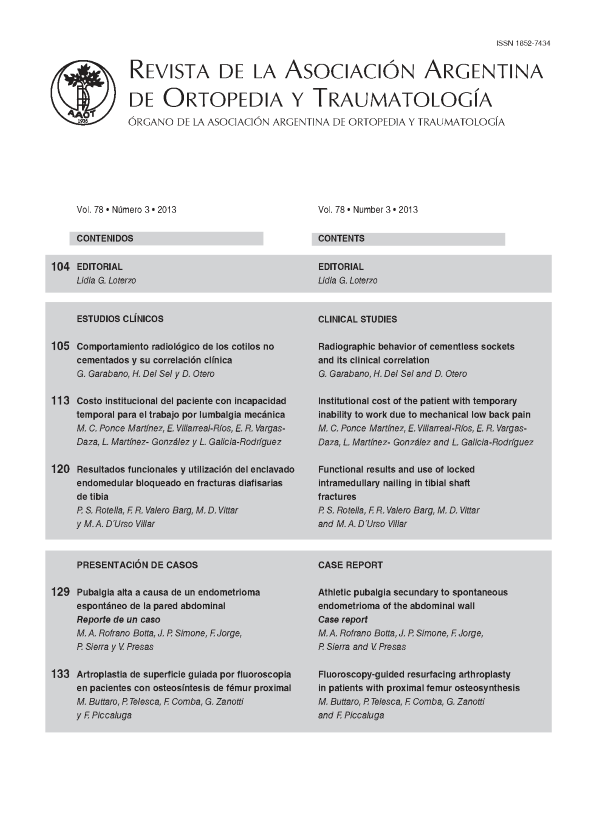Comportamiento radiológico de los cotilos no cementados y su correlación clínica. [Radiographic behavior of cementless sockets and its clinical correlation]
Contenido principal del artículo
Resumen
Descargas
Métricas
Detalles del artículo

Esta obra está bajo licencia internacional Creative Commons Reconocimiento-NoComercial-CompartirIgual 4.0.
La aceptación del manuscrito por parte de la revista implica la no presentación simultánea a otras revistas u órganos editoriales. La RAAOT se encuentra bajo la licencia Creative Commons 4.0. Atribución-NoComercial-CompartirIgual (http://creativecommons.org/licenses/by-nc-sa/4.0/deed.es). Se puede compartir, copiar, distribuir, alterar, transformar, generar una obra derivada, ejecutar y comunicar públicamente la obra, siempre que: a) se cite la autoría y la fuente original de su publicación (revista, editorial y URL de la obra); b) no se usen para fines comerciales; c) se mantengan los mismos términos de la licencia.
En caso de que el manuscrito sea aprobado para su próxima publicación, los autores conservan los derechos de autor y cederán a la revista los derechos de la publicación, edición, reproducción, distribución, exhibición y comunicación a nivel nacional e internacional en las diferentes bases de datos, repositorios y portales.
Se deja constancia que el referido artículo es inédito y que no está en espera de impresión en alguna otra publicación nacional o extranjera.
Por la presente, acepta/n las modificaciones que sean necesarias, sugeridas en la revisión por los pares (referato), para adaptar el trabajo al estilo y modalidad de publicación de la Revista.
Citas
2. Clohisy JC, Harris WH. Matched-pair analysis of cemented and cementless acetabular reconstruction in primary THA. J Arthroplasty 2001;16:697-705.
3. Rorabeck CH, Bourne RB. The Nicolas Andry award: Comparative results of cemented and cementless THA. Clin Orthop 1996;325:330-44.
4. Wroblewski BM, Siney PD, Fleming PA. Charnley low-friction arthroplasty: survival patterns to 38 years. J Bone Joint Surg Br
2007;89:1015-18.
5. Bjorgul K, Novicoff WM, Wiig M. No differences in outcomes between cemented and uncemented acetabular components after 12-14 years: results from randomized controlled trial comparating Duraloc with Charnley cups. J Orthopaed Traumatol 2010;11:37-45.
6. Hozack WJ, Rothman RH, Balderson RA. Cemented versus cementless THA: a comparative study of equivalent patient populations. Clin Orthop 1990;289:161-5.
7. Rothman RH, Cohn JC. Cemented versus cementless THA: a critical review. Clin Orthop 1990;254:153-69.
8. Makela K, Eskelinen A, Remes V. Cemented THR for primary osteoarthritis in patients aged 55 years or older. J Bone Joint Surg Br 2008;90:1562-9.
9. Gaffey JL, Callaghan JJ, Pedersen DR. Cementless acetabular fixation at fifteen years. J Bone Joint Surg Am 2004;86:257-61.
10. Chougle A, Hemmady MV, Hodgkinson JP. Long-term survival of acetabular components after THA with cement in patients with development dysplasia of the hip. J Bone Joint Surg Am 2006;88:71-9.
11. Laupacis A, Bourne R, Rorabeck C. Comparison of THA performed with and without cement. J Bone Joint Surg Am 2002;84:1823-8.
12. Engh CA, Massin P. Cementless THA using an anatomic medullary locking stem. Clin Orthop 1989;249:141-58.
13. Grubl A, Chiari C, Wolf F. Cementless THA with tapered, rectangular titanium stem and threaded cup. J Bone Joint Surg Am 2002;84:425-31.
14. Epinette JA, Manley MT, Capello WN. A 10-years minimum follow-up of hidroxyapatite-coated threaded cups. J Arthroplasty 2003;18:140.
15. Ihle M, Mai S, Siebert W. The results of titanium-coated RM acetabular component at 20 years. J Bone Joint Surg Br 2008;90:1284-90.
16. DeLee JG, Charnley J. Radiological demarcation of cemented sockets in THR. Clin Orthop Relat Res 1976;121:20-32.
17. Hodgkinson JP, Shelley P, Wroblewski BM. The correlation between the roentgenographic appearence and operative findings at the bone cement junction of the socket in Charnley low friction arthroplasties. Clin Orthop Relat Res 1988;228:105-9.
18. Udomkiat P, Wan Z, Dorr LD. Comparison of preoperative radiographs and intraoperative findings of fixation of hemispheric porous coated sockets. J Bone Joint Surg Br 2001;12:1865-70.
19. Udomkiat, P, Dorr LD, Wan Z. Cementless hemispheric porous coated sockets implanted with press-fit technique without screws. J Bone Joint Surg Am 2002;84:1195-1201.
20. Moore MS, McAuley JP, Engh ChA. Radiographic signs of osseointegration in porous-coated acetabular components. Clin Orthop Relat Res 2006;444:176-83.
21. Sandborn PM, Cook SD, Kester MA. Tissue response to porous coated implants lacking initial bone apposition. J Arthroplasty 1988;3:4:337-46.
22. Schmalzried T, Harris WH. The Harris-Galante porous coated acetabular component with screw fixation. J Bone Joint Surg
1992;74:1130-9.
23. Curtis MJ, Wilson VD, Hungerford DS. The initial stability of uncemented acetabular components. J Bone Joint Surg Br 1992;74(3):372-7.
24. Adler E, Stuchin SA, Kummer FJ. Stability of press-fit acetabular cups. J Arthroplasty 1992;7:295-301.
25. Cook SD, Thomas KA, Whitecloud TS. Tissue growth into porous coated acetabular components in 42 patients. Clin Orthop Relat Res 1992;283:163-70.
26. Van Flandern GJ, Bierbaum BE, Karpos PAG. Intermediate clinical follow-up of a dual-radius acetabular component. J Arthroplasty 1998;13;7:804-11.
27. Spak RT, Stuchin SA. Cementless porous coated sockets without holes implanted with pure press fit technique. J Arthroplasty
2005;20:4-11.
28. Macheras GA, Papagelopoulos PJ, Karachalios TS. Radiological evaluation of metal-bone interface of a porous tantalum monoblock acetabular component. J Bone Joint Surg Br 2006;8B:304-9.
29. Callaghan J, Savory CG. The uncemented porous coated anatomic total hip prosthesis. J Bone Joint Surg Am 1988;70:337-46.
30. Kwong LM, Jasty M, Harris WH. Correlation between radiographic assessment of acetabular component stability and micromotion in autopsy retrieved cemented THR. Clin Orthop Relat Res 1991;16:247-55.
31. Pidhorz LE, Urban RM, Galante JO. A quantitative study of bone and soft tissues in cementless porous coated acetabular components retrieved autopsy. J Arthroplasty 1993;8:2:213-25.

